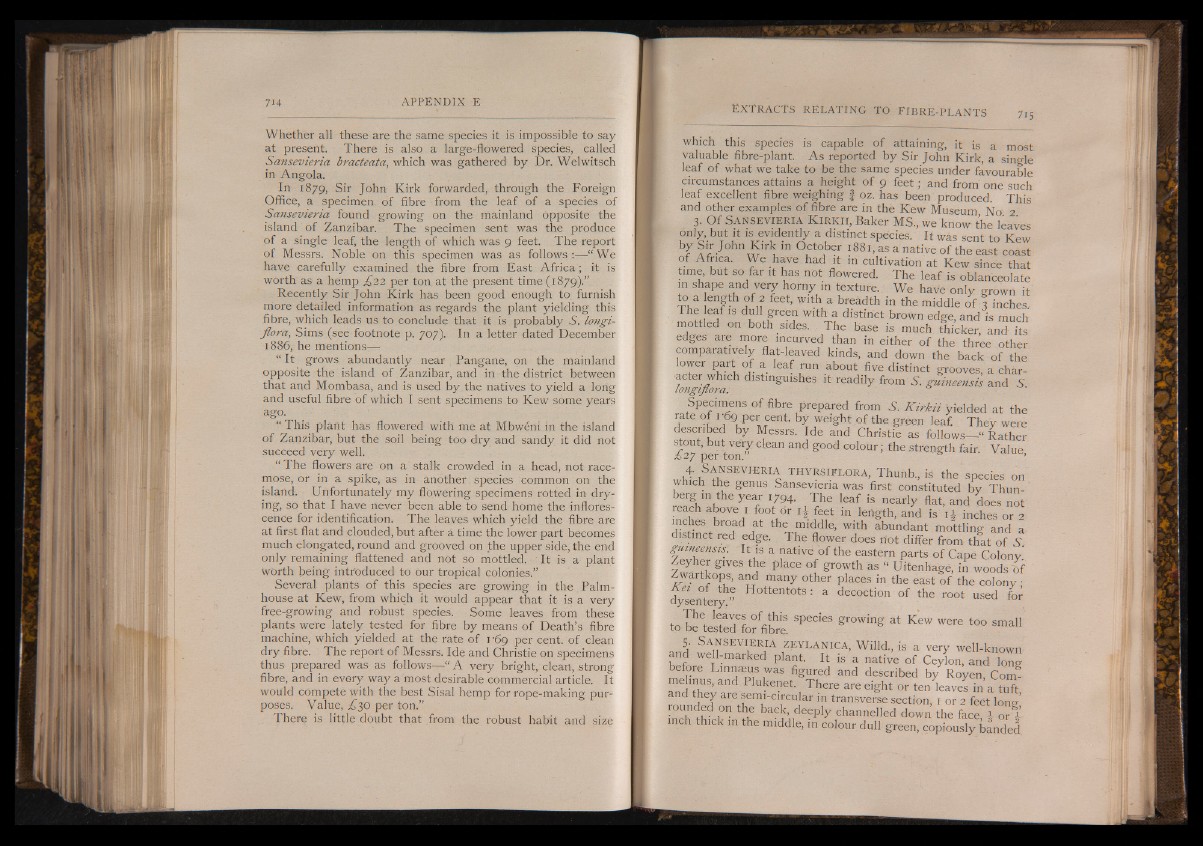
Whether all these are the same species it is impossible to say
at present. There is also a large-flowered species, called
Sansevieria bracteata, which was gathered by Dr. Welwitsch
in Angola.
In 1879, Sir John Kirk forwarded, through the Foreign
Office, a specimen, of fibre from the leaf of a species of
Sansevieria found growing on the mainland opposite the
island of Zanzibar. The specimen sent was the produce
of a single leaf, the length of which was 9 feet. The report
of Messrs. Noble on this specimen was as follows “ We
have carefully examined the fibre from East Africa; it is
worth as a hemp £22 per ton. at the present time (1879).”
Recently Sir John Kirk has been good enough to furnish
more detailed information as regards the plant yielding this
fibre, which leads us to conclude that it is probably S', longi-
jiora, Sims (see footnote p. 7° 7)- In a letter dated December
1886, he mentions—
“ It grows abundantly near Pangane, on the mainland
opposite the island of Zanzibar, and in the district between
that and Mombasa, and is used by the natives to yield a long
and useful fibre of which I sent specimens to Kew some years
ago.
“ This plant has flowered with me at Mbweni in the island
of Zanzibar, but the soil being too dry and sandy it did not
succeed very well.
“ The flowers are on a stalk crowded in a head, not racemose,
or in a spike, as in another species common on the
island. Unfortunately my flowering specimens rotted in drying,
so that I have never been able to send home the inflorescence
for identification. The leaves which yield the fibre are
at first flat and clouded, but after a time the lower part becomes
much elongated, round and grooved on the upper side, the end
only remaining flattened and not so mottled. It is a plant
worth being introduced to our tropical colonies.”
Several plants of this species are growing in the Palm-
house at Kew, from which it would appear that it is a very
free-growing and robust species. Some leaves from these
plants were lately tested for fibre by means of Death’s fibre
machine, which yielded at the rate of 1-69 per cent, of clean
dry fibre. The report of Messrs. Ide and Christie on specimens
thus prepared was as follows— “ A very bright,.clean, strong
fibre, and in every way a most desirable commercial article. It
would compete with the best Sisal hemp for rope-making purposes.
Value, ,£30 per ton.”
There is little doubt that from the robust habit and size
which this species is capable of attaining, it is a most
valuable fibre-plant. As reported by Sir John Kirk, a single
leaf of what we take to be the same species under favourable
circumstances attains a height of 9 fe et; and from one such
leaf excellent fibre weighing § oz. has been produced. This
and other examples of fibre are in the Kew Museum No 2
3. Of SANSEVIERIA K i r k i i , Baker MS., we know the leaves
only, but it is evidently a distinct species. It was sent to Kew
* ? f ‘/ '; °hnw irkJ n (% ,er 1 ^ 1 ’^s a native of the east coast
of Africa. We have had it in cultivation at Kew since that
time, but so far it has not flowered. The leaf is oblanceolate
in shape and very horny in texture.. We have only grown it
to a ength of 2 feet, with a breadth in the middle of 3 inches
W m S M H M | | witlpa distinct brown edge, and is much
mottled on both sides. The base is much thicker, and its
edges are more incurved than in either of the three other
comparatively flat-leaved kinds, and down the back of the
lower part of a leaf run about five distinct grooves, a char-
^Im^iflora gulshes readily from V. guineensis and 5 .
Specimens of fibre prepared from 5 . K irk ii yielded at the
rate of 1-69 per cent. by weight .of the green leaf. They were
described by Messrs. Ide and Christie as follows— “ Rather
stout, but very clean and good colour; the strength fair. Value
*27 per ton. ’
w p t l f lNSEVIERIi THYRSIFLORA, Thunb., is the species on
which the genus Sansevieria was first constituted by Thunberg
m the year 1794. The leaf is nearly flat, and does not
reach abo ve1 foot or i f feet in length, and is i f inches or 2
inches broad at the middle, with abundant mottling and a
istinct red edge. The flower does riot differ from that of S
guineensis. It is a native of the eastern parts of Cape Colony
Zeyher gives the place of growth as “ Ultenhage, in woods of
¿wartkops, and many other places in the east of the colony •
dyseriter ” Hottentots •' a decoction o f the root used for
g f e j 1 1 1 # species growing at Kew were too small
to be tested for fibre.
5- S a n s e v i e r i a z e y l a n i c a , Willd., is a very well-known
and well-marked plant. It is a native of Ceylon, and long
before Linna.us was figured and described by Royen, Com-
melmus.and Plukenet There are eight or ten leaves in a tuft
j 16/ are fenV'clrcular in transverse section, 1 or 2 feet long’
[n T fP ,°n 'S t m ,deeply channelled down the face, I or f
ck in the middle, in colour dull green, copiously banded.